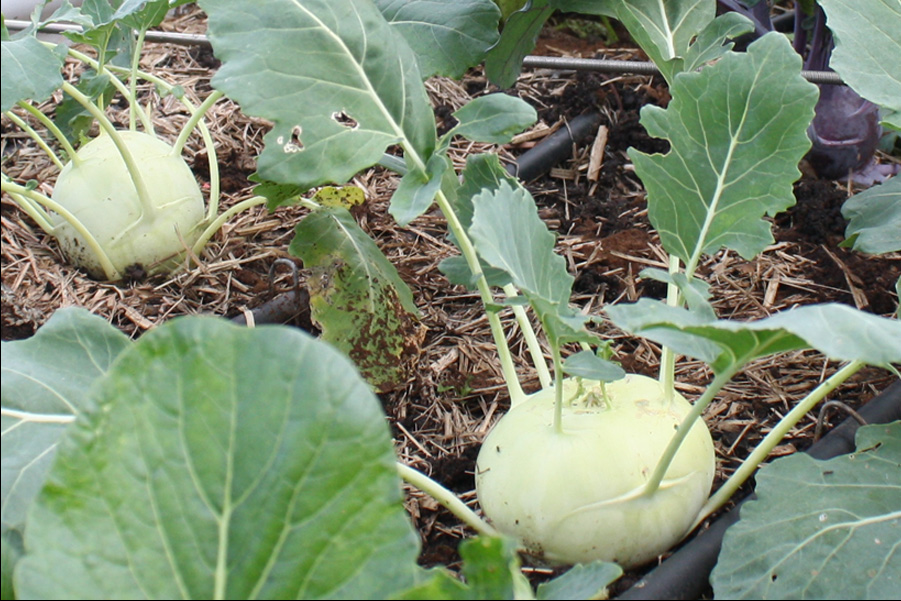Botanical name:
Brassica oleracea var. gongylodes
Description:
Kohlrabi is closely related to broccoli. It is grown for it’s bulbous, swollen stem which comes in a light green and a purple variety. The kohlrabi bulb reaches about 10 cm in diameter. The leaves grow directly from the bulbous stem and are up to 40 cm long. They are green and are covered with a waxy substance, which is perfectly fine.
The flesh is white, regardless of the color of it’s outer layer and leaf ribs. Kohlrabi is reported to be high in vitamin C and a good source of fiber. The main vegetable is the bulb, but as a kohlrabi is a member of the cabbage family, everything is edible. If kohlrabi goes to flower it shows the typical cross-shaped flower of the cabbage family with four petals.
How to grow:
Sow 12 mm deep in seedbeds, seedlings emerge in 6-10 days. Transplant to single pots when about 5 cm high. Grow to about 15 cm, feeding with liquid fertiliser. Transplant to a sunny spot into rich, lightly textured soil with plenty of well rotted compost dug in. Plant 30 cm apart. Mulch to keep the soil moist. Needs consistent watering.
Doesn’t need much fertilising.
Harvest in 8-10 weeks.
Growing in the neighbourhood:
Likes beetroot, cucumber, onions, marigold and nasturtium, doesn’t like climbing beans and members of the nightshade family (tomato, capsicum, eggplant, chili)
Pests and other problems and how we deal with them:
Caterpillars of butterflies, especially the white cabbage butterfly are pests on kohlrabi. We keep them out by netting the bed with a 5-10 mm net as long as the plants are small. A bit of leaf loss on mature plants is tolerable, if caterpillars take away too much leaf material we spray the plants with a bacterial solution that controls them.
All members of the cabbage family can be affected by a single-celled organism deforming the roots and making it hard for the plants to take up water. The problem is called club root and requires serious soil treatment. We try to avoid this by strictly rotating crops.
Season:
Spring to late Autumn
Seed-saving:
Kohlrabi cross pollinates with other plants of the cabbage family. In order to collect useful seeds the mother-plant would need to be kept isolated.
How to harvest and use:
Harvest bulbs when they are the size of an orange, so the texture is tender and not woody and the flesh is sweet. Main vegetable is the bulb, but the leaves can be used like collard greens. If the leaves are not used they go to the compost, as does the root.
Kohlrabi’s flavor compares to broccoli stems, sweet and mild with a hint of cabbage. The texture is firm and crisp and the flesh is juicy. Peel kohlrabi bulb, removing any fibrous and woody parts. Kohlrabi is great used raw and cooked. It can be grated raw for salads and slaws. Shred it to make fritters. Add chunks to soups or veggie stir-fries. Make a kohlrabi gratin with a mild cheese sauce or just plain butter and thyme. It pairs very well with Indian spices in vegetable curries. Larger kohlrabi is often stuffed like squash. It keeps in the fridge for several weeks.
